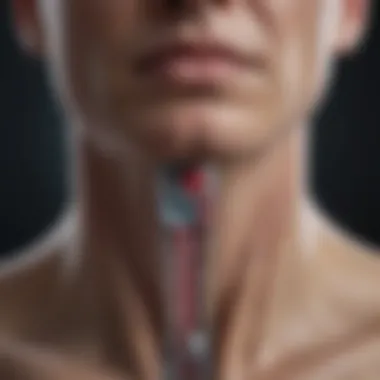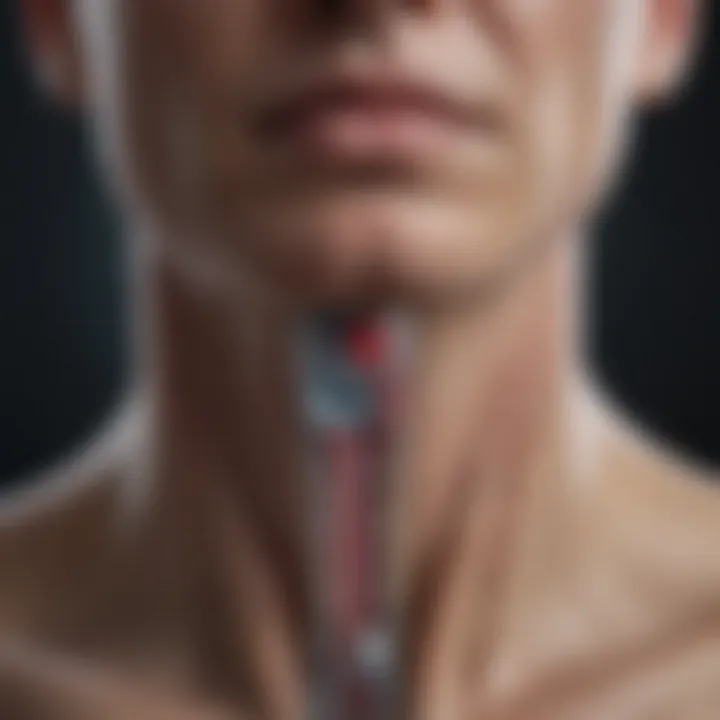Understanding the Z-line in the Esophagus


Intro
The Z-line, also known as the squamocolumnar junction, serves as a crucial delineation within the esophagus, marking the transition from the esophageal squamous epithelium to the columnar epithelium of the stomach. Its presence is not merely anatomical; it has significant implications in various physiological processes and pathological conditions. This section explores the vital aspects tied to the Z-line, emphasizing its relevance in understanding various gastrointestinal disorders, notably gastroesophageal reflux disease (GERD) and Barrett's esophagus. The significance of the Z-line extends to diagnostic methods and treatment approaches associated with its abnormalities, making it essential knowledge for healthcare professionals, researchers, and educators alike.
Key Findings
Major Results
- Location and Anatomy: The Z-line is located approximately at the junction where the esophagus meets the stomach. This region is not only key in facilitating the transition in epithelial type but also in protecting the esophagus from stomach acids.
- Physiological Role: The Z-line is integral to normal swallowing and prevents the backflow of gastric contents. Misfunction at this junction can lead to various disorders.
- Clinical Significance: Abnormal changes in the Z-line can indicate diseases such as GERD and Barrett's esophagus. Understanding these conditions requires knowledge of how the Z-line functions and its anatomical aspects.
Discussion of Findings
The correlation between the Z-line and gastrointestinal disorders cannot be overstated. In individuals with GERD, for example, the frequent exposure of the esophagus to gastric acid can provoke changes at the Z-line, contributing to discomfort and other symptoms. Furthermore, alterations in the Z-line can serve as a precursor to Barrett's esophagus, a condition where normal squamous cells are replaced by columnar cells, heightening the risk of esophageal cancer. This transformation highlights the Z-line’s role not just in structure, but in disease progression.
Methodology
Research Design
The study of the Z-line often incorporates a blend of observational and diagnostic research methods to gather comprehensive insights. This includes clinical evaluations, endoscopic examinations, and histological analyses to observe changes at the epithelial junction.
Data Collection Methods
Data pertaining to the Z-line can be collected through:
- Endoscopy: Allows for visual assessment and biopsy.
- Histopathological Examination: Analyzes tissue samples for cellular changes.
- Patient Surveys: Collects data on symptoms relating to esophageal disorders.
- Longitudinal Studies: Track disease progress over time.
Understanding these methodologies provides a framework for analyzing the health of the Z-line and its importance across various gastrointestinal conditions. The commitment to continuous research in this area supports advancements in diagnostics and treatments, ultimately enhancing patient care.
Prologue to the Z-line
The Z-line, also known as the squamocolumnar junction, marks a fundamental transition within the esophagus. Understanding the Z-line is essential for grasping its role in various physiological functions and its significance in numerous gastrointestinal disorders. This junction not only serves as a critical marker in the anatomy of the esophagus but also is pivotal in the study of conditions like gastroesophageal reflux disease (GERD) and Barrett's esophagus.
Definition and Location
The Z-line is located at the intersection where the esophageal squamous epithelium meets the gastric columnar epithelium. This precise anatomical point is often identifiable during an endoscopy as a distinct line or junction.
In humans, the Z-line typically lies at the level of the diaphragm, approximately 40 centimeters from the teeth. This location can vary among individuals but consistently represents the threshold between the esophagus and stomach. Understanding its position is crucial for clinicians and researchers exploring the esophagus's functionality and pathology.
Historical Perspective
Historically, the Z-line has been recognized for its clinical significance. In the early understanding of gastrointestinal anatomy, it was often neglected. However, as advancements in endoscopic techniques occurred in the late 20th century, appreciation for this junction began to grow.
Research from these developments highlighted how abnormalities in the Z-line could indicate underlying diseases. The documentation of conditions like Barrett's esophagus sparked interest in studying the Z-line relation to esophageal carcinomas and other disorders. This evolving narrative emphasizes the Z-line's role in diagnosing and managing esophageal conditions, drawing attention to its physiological and pathological implications.
The ongoing research and medical interest around the Z-line now underscore its importance not just as a landmark but also as a focal point for understanding esophageal health.


Anatomical Features of the Z-line
The anatomical features of the Z-line are fundamental for understanding the complexities of the esophagus and its junction with the stomach. The Z-line, or squamocolumnar junction, serves as a critical landmark, facilitating a clearer understanding of both normal and pathological processes. This section explores the histological composition and physiological significance, underlining how these aspects are interconnected.
Histological Composition
Squamous Epithelium
The squamous epithelium is a key component of the Z-line. It lines the esophagus and is characterized by its thin, flat structure, enabling efficient passage of food. This specific aspect of squamous epithelium provides a robust barrier against mechanical damage and pathogens. One significant characteristic is its multilayered nature, which is beneficial in protecting underlying tissues from abrasive substances and acidic conditions.
A unique feature of squamous epithelium is its ability to undergo rapid cell turnover. This advantage means that it can heal quickly from injuries that may occur due to the passage of food or other irritants. However, it is also more vulnerable to damage from corrosive substances, such as gastric acid.
Columnar Epithelium
In contrast, the columnar epithelium is present in the stomach, playing a different yet complementary role. This epithelium is characterized by its taller column-like cells which are involved in secretion and absorption. Its primary aspect in relation to the Z-line is its ability to produce mucus, which protects the stomach lining from harsh acids and digestive enzymes.
The beneficial characteristic of the columnar epithelium is its secretory ability, which aids in digestion and nutrient absorption. A unique advantage of this type of epithelium is its specialized cells that secrete gastric juices. Yet, this epithelium is less effective in protecting against physical damage, which can pose a risk during reflux events where stomach contents enter the esophagus.
Muscularis Layer
The muscularis layer, while not an epithelial component, plays a crucial role in the functionality of the Z-line. This muscular layer enables coordinated contractions, ensuring the effective movement of food through the esophagus. The key aspect of this layer is its two components: the inner circular and outer longitudinal muscles, which work together in peristalsis. Its unique feature is the presence of smooth muscle fibers, which allow for involuntary control. This characteristic helps in the coordination of swallowing and digestion. Nevertheless, disorders affecting this layer can lead to motility issues, affecting the Z-line's integrity and functioning.
Physiological Significance
Barrier Function
The Z-line acts as a critical barrier, separating the squamous and columnar epithelia. This barrier function prevents gastric contents from damaging the esophageal lining. The distinct characteristic of this boundary is its ability to facilitate a controlled environment for the esophagus versus the stomach, making it a beneficial focus for understanding gastrointestinal health.
One unique feature is the maintenance of a different pH level between the esophagus and stomach. This differential is vital for digestive processes, underscoring the importance of the barrier function. However, when this barrier is compromised, it may lead to conditions such as gastroesophageal reflux disease (GERD).
Role in Digestion
The Z-line also plays a significant role in the overall digestive process. Its positioning affects how food transitions from the esophagus to the stomach, ensuring efficient processing. This aspect makes the Z-line integral to understanding how food is managed within the digestive tract. The key characteristic here is the coordination of muscular movements at the Z-line, which optimizes the passage of food. A unique feature related to its role in digestion is how the Z-line contributes to preventing the backflow of stomach contents. This prevents potential damage to the esophagus and maintains digestive efficiency. Disadvantages may arise when these mechanisms fail, leading to reflux and related complications.
Clinical Relevance of the Z-line
The Z-line is clinically significant due to its pivotal role in understanding esophageal conditions. This junction between the squamous epithelium and columnar epithelium is not just an anatomical point, but a key structure influencing various gastrointestinal disorders. Notably, its implications in gastroesophageal reflux disease (GERD) and Barrett's esophagus are often explored. These associations highlight the Z-line's critical role in diagnosis and treatment strategies.
Gastroesophageal Reflux Disease
Pathophysiology
The pathophysiology of GERD involves the abnormal reflux of gastric contents into the esophagus, which disrupts the Z-line. This condition leads to inflammation and damage to the esophageal lining. One key characteristic of GERD is the sphincter dysfunction at the lower esophageal junction. This contributes to the hallmark symptom of heartburn, but also implicates the Z-line in long-term complications like Barrett's esophagus. Understanding the unique features of this relationship aids in guiding effective management strategies for GERD, making it an integral part of this discourse.
Symptoms and Diagnosis
Symptoms of GERD are varied and can range from typical ones like heartburn to atypical symptoms such as chronic cough or laryngitis. The diagnosis is primarily based on clinical presentation and may include endoscopy, where the Z-line's condition is evaluated. The persistence of symptoms often makes GERD a significant topic in discussions about the Z-line. Recognizing the unique features of each symptom helps clarify the necessary diagnostic approach, ensuring more accurate treatment pathways.
Management Strategies
Effective management strategies for GERD may involve lifestyle modifications, pharmacotherapy, or surgery in some cases. The rising prevalence of this condition makes it crucial to explore these management options. Notably, proton pump inhibitors are common pharmacological choices. Their mechanism in reducing gastric acid production emphasizes the relationship between gastric acidity and the Z-line’s integrity. Assessing advantages and disadvantages of management strategies can help inform better treatment plans tailored to individual patient needs.
Barrett's Esophagus


Definition and Risk Factors
Barrett's esophagus refers to a condition where the squamous lining of the esophagus is replaced by columnar cells, often as a consequence of chronic GERD. Recognizing the risk factors is essential for prevention and early detection. Factors like obesity, smoking, and age significantly increase the risk of developing Barrett's. Highlighting these risks provides essential information that emphasizes the need for monitoring individuals with chronic reflux, bridging both anatomical and clinical contexts.
Diagnosis and Monitoring
Diagnosis of Barrett's esophagus frequently involves upper endoscopy with biopsy to confirm the cellular changes at the Z-line. Monitoring these patients is critical, as the condition can progress to esophageal adenocarcinoma. The process of regular surveillance underscores the unique diagnostic strategies required to manage Barrett's esophagus effectively. Potential challenges include patient compliance and the need for recurrent endoscopic evaluations.
Treatment Options
Treatment options span from regular surveillance to surgical options, depending on the extent of cellular changes and dysplasia present. Although endoscopic therapies exist, such as radiofrequency ablation, they are determined based on individual risk profiles. Their effectiveness in preventing progression to esophageal cancer makes these treatment strategies a focal point in addressing Barrett's esophagus. Approaching treatment requires a balance between therapeutic efficacy and patient risk factors.
Diagnosis of Z-line Abnormalities
The diagnosis of Z-line abnormalities is crucial for understanding various esophageal conditions. The recognition of changes at this anatomical landmark can provide important insights into underlying gastrointestinal disorders. Evaluating these abnormalities allows healthcare professionals to assess the health of the esophagus and make informed decisions about further management.
Abnormalities of the Z-line can indicate conditions such as gastroesophageal reflux disease (GERD) and Barrett's esophagus. These abnormalities may present with additional symptoms like dysphagia, heartburn, or chest pain. Consequently, timely diagnosis can significantly impact treatment options and patient outcomes.
Endoscopic Techniques
Endoscopic techniques are primary methods for assessing Z-line abnormalities. These procedures enable the direct visualization of the esophagus, allowing for a thorough evaluation of the Z-line and its surrounding structures.
Upper Endoscopy
Upper endoscopy, also known as esophagogastroduodenoscopy (EGD), is commonly used to examine the esophagus. During this procedure, a flexible tube with a camera is inserted through the mouth and into the esophagus. One of the key characteristics of upper endoscopy is its ability to provide real-time images of the Z-line's appearance.
This method is a preferred choice because it allows for both visualization and intervention if needed. A unique feature of upper endoscopy is its capacity to perform biopsies during the same session, which can help in assessing cellular changes. Moreover, this technique is beneficial in the determination of potential risks associated with Barrett's esophagus or other conditions. However, upper endoscopy may present risks such as sedation-related complications.
Barium Swallow Tests
Barium swallow tests are another technique utilized in diagnosing Z-line abnormalities. This radiographic examination involves swallowing a barium solution, which coats the esophagus and provides contrast during X-ray imaging. A key characteristic of barium swallow tests is their ability to highlight structural changes in the esophagus.
This method offers the advantage of being less invasive than upper endoscopy and can be particularly useful for patients who may have contraindications for sedation. However, it does not provide histological information, which limits its comprehensiveness in diagnosis. The presence of reflux or stricture can be identified, but definitive assessment of the Z-line requires additional techniques.
Biopsy Analysis
Biopsy analysis plays a critical role in the diagnosis of Z-line abnormalities. This process involves taking a small tissue sample during an endoscopic procedure. The examination of this tissue is essential for identifying any cellular atypias or dysplasia. Pathologists can determine whether there are changes consistent with Barrett's esophagus or other conditions, guiding appropriate treatment strategies. Biopsy results can also assist in monitoring changes over time, offering valuable insights into disease progression or response to therapy.
Current Research on the Z-line
The Z-line is gaining increased attention in recent studies due to its significant role in both the anatomy and pathology of the esophagus. Understanding this area assists in diagnosing and managing gastrointestinal disorders. Current research focuses on innovative methods for diagnosis and potential therapeutic approaches, which could greatly improve patient outcomes.
Innovative Diagnostic Tools
There is a growing emphasis on developing diagnostic tools that enhance the accuracy and efficiency of identifying Z-line abnormalities. One notable area of research involves advanced imaging techniques. For instance, high-resolution endoscopy provides detailed visualization of the esophagus and its anatomical features. This allows for better detection of subtle changes at the Z-line, which may be crucial for early intervention.


Additionally, machine learning algorithms are being explored to analyze endoscopic images more efficiently. These algorithms can assist in identifying patterns that are often missed by the human eye. By incorporating artificial intelligence, healthcare professionals may be able to increase the precision of diagnoses related to the Z-line.
Another area of focus is the use of biomarkers in conjunction with traditional diagnostics. Blood tests that identify specific markers could complement imaging studies, offering a more comprehensive assessment. This dual approach could provide deeper insights into the condition of the Z-line and inform subsequent treatment strategies.
Emerging Therapies
As research continues, there is a concerted effort to identify and develop new therapies targeting conditions associated with the Z-line, particularly Barrett's esophagus and GERD. Emerging therapies aim to address the underlying causes of these disorders rather than merely alleviating symptoms.
One promising direction involves the use of ablative techniques for Barrett's esophagus. These methods, including radiofrequency ablation, aim to eradicate the abnormal cells at the Z-line. Clinical trials are ongoing to evaluate the effectiveness of these interventions and establish optimal protocols for treatment.
Additionally, pharmacological advancements are being explored. New medications may help regulate the acid production in the stomach, thereby reducing damage to the esophageal lining at the Z-line. Ongoing studies are assessing various compounds for their long-term efficacy and safety in controlling symptoms associated with GERD.
"Understanding these new developments in diagnosis and therapy can lead to better management of esophageal disorders, improving quality of life for affected patients."
Future Directions in Z-line Research
The exploration of the Z-line in the esophagus is evolving, presenting numerous opportunities for advancement. The future directions in Z-line research hold significant promise for improving diagnostic methods and treatment approaches. A clear focus on this area enhances understanding of gastrointestinal disorders, particularly in relation to diseases such as gastroesophageal reflux and Barrett's esophagus. Research in this field can lead to more precise clinical interventions and improved patient outcomes.
Interdisciplinary Approaches
Interdisciplinary collaboration is vital in Z-line research. Engaging professionals from varied fields such as gastroenterology, pathology, molecular biology, and bioinformatics fosters a comprehensive understanding of Z-line abnormalities. For example:
- Molecular Biology: Understanding genetic factors that influence Z-line transitions can provide insight into disease pathways. This can aid in identifying patients at higher risk of conditions like Barrett's esophagus.
- Bioinformatics: Utilizing data analysis tools to examine large sets of biological data allows for the identification of patterns and correlations that might otherwise remain unnoticed.
- Pathology: A detailed study of tissue samples can enhance the understanding of the histological characteristics associated with Z-line disorders, leading to better diagnostic tools.
By integrating these fields, researchers can develop innovative strategies that advance the understanding of the Z-line and its implications in various conditions. This collaborative drive may pave the way for breakthroughs in treatment and prevention.
Impact of Technology
Technological advancements are reshaping Z-line research in profound ways. Tools and methods that were once limited are now more sophisticated, impacting both diagnosis and treatment.
- Imaging Techniques: Enhanced imaging technologies, such as high-resolution endoscopy and optical coherence tomography, allow for better visualization of the Z-line. These methods provide clearer images of abnormalities and contribute to more accurate diagnoses.
- Artificial Intelligence: AI algorithms are being developed to analyze endoscopic images and recognize Z-line abnormalities. This could drastically reduce diagnostic errors and expedite the evaluation process for clinicians.
- Genomic Sequencing: With the price of genomic sequencing dropping, more research is focusing on the genetic underpinnings of Z-line conditions. Identifying genetic markers associated with these disorders can inform screening and treatment strategies.
The integration of these technological innovations not only streamlines diagnostic processes but also enhances treatment options, potentially improving patient management and outcomes.
"The future of Z-line research is dependent on a concerted effort across disciplines and the effective use of technology, ensuring that advancements translate into better healthcare practices."
As this area of research progresses, ongoing studies and collaborative efforts remain essential for unraveling the complexities associated with the Z-line in the esophagus.
Culmination
The conclusion of this article plays a crucial role in synthesizing the information provided throughout. It serves as a summary that encapsulates the significance of the Z-line in the esophagus. The Z-line not only marks a vital transition in tissue types but also has far-reaching implications in understanding various gastrointestinal disorders. Key points discussed include its anatomical features, physiological roles, and clinical relevance, particularly in conditions like gastroesophageal reflux disease and Barrett's esophagus.
Summary of Key Points
In summary, the Z-line is a notable landmark that facilitates a deeper understanding of the esophagus's anatomy and its functions. The key points to remember include:
- The Z-line represents the squamocolumnar junction between the esophagus and stomach.
- Its histological composition, primarily featuring squamous and columnar epithelial tissues, is essential for barrier function.
- The Z-line is significant in conditions such as GERD and Barrett's esophagus, which necessitate accurate diagnosis and management.
- Current research and future directions emphasize the need for interdisciplinary approaches and innovative diagnostic tools.
Call for Further Research
The study of the Z-line is an evolving field. There are many areas where further research is beneficial. Future investigations should consider the following aspects:
- Understanding the Molecular Mechanisms: Investigate the molecular changes at the Z-line that could lead to abnormal conditions.
- Exploring New Diagnostic Technologies: Focus on the development of non-invasive diagnostic tools that can accurately assess abnormalities in the Z-line.
- Longitudinal Studies on Barrett's Esophagus: More studies are needed to evaluate the progression of Barrett's esophagus over time and its association with esophageal cancer.



